1-Line Summary: Atomic Habits by James Clear, you’ll learn why habits are atomic in nature and how you can achieve remarkable results in your life by making small changes in your habits.
Who should read Atomic Habits Summary? And why?
I think everybody should read this book.
Why? Because our life is the result of our habits.
We all have habits.
Some are good. And some are bad!
We must know how to add good habits and avoid bad ones.
Best Tools for Bibliophiles
- Listen to your Favorite Books on The Go: Try Audible and Get Up To 2 Free Audiobooks | Get 3 Free Audiobooks
- Read over 2 million e-books on any device: Sign up for 30 days free trial of Kindle Unlimited and read your favorite titles.
- Get free 2-day shipping of your favorite books and stream premium TV shows on Amazon Prime: Sign up for 30 days free trial of Amazon Prime.
- I use Notion to take reading notes, plan everything, and run all my businesses. (Notion is my Second Brain 🤯): Get Notion for free for personal use (paid for teams/businesses)
Atomic Habits by James Clear Book Summary (PDF)
In this book summary, I’ll share all the big lessons I learned from this book.
You’ll be learning some amazing stuff!
So without wasting any time …
Let’s dive right in!
What are habits? And why should you take them seriously?
Here is how the author puts it:
“Habits are the compound interest of self-improvement.”
You want to improve yourself, right? That’s the reason you are reading this.
So what are habits?
In SUPER simple words: Habits are behaviors your brain hardly requires any effort to perform.
So every repetitive thing that you do every day in your life is a result of habit.
Examples:
- Brushing your teeth.
- Tying your shoelaces.
- Watching YouTube videos.
- Making stories in your mind.
It could be a long list!
You just don’t realize when you perform a habit.
Why should you read about habits?
Because you REPEAT them every single day.
What you do every day determines where you will be after 3 to 4 years.
Those very habits are building your life.
The results you have right now, or the situation you are in in your life, it’s all the result of your habits.
Want to achieve big? Stop setting goals. Build Systems instead!
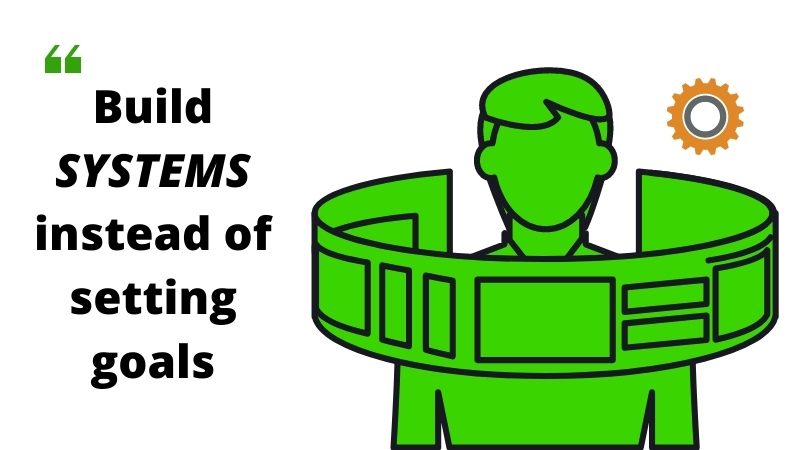
This is the biggest takeaway from this book.
Goal setting is fantastic.
But the real magic is in building systems that actually work.
The thing is:
Often people set unrealistic goals.
What happens then is, somewhere during their journey, they get demotivated.
This usually happens when things don’t go their way.
As things get more demanding, the vision of achieving those goals fades away.
It doesn’t mean that you should not set goals at all.
The point is:
Have a system that allows you to achieve that goal even when you don’t want to push hard during crazy times.
If you talk about self-improvement, building habits is the best way to build improvement systems.
There is a reason that the author calls them atomic habits.
Atomic means that habits are the building blocks of your life.
Imagine your life as a giant machine with different components – all working in harmony with each other. Would you want any of the parts to be weak? No!
Similarly, you have got to set the right habits in your life to become a high-performance machine and achieve all your goals.
If you just set goals without having a robust system in place, it may take longer to achieve those goals.
Habits are really powerful.
If you master the art of building high-performance habits, you can build your dream life.
Let’s face the truth:
It’s hard to build habits, isn’t it?
We all know, right?
We know how hard it is to introduce a good habit in our daily routines.
But that’s not the whole thing.
From what I learned from this book and have seen in my life, it’s easy to build bad habits and hard to build good habits.
Maybe it’s the opposite for you. But for most people, bad habits come to them naturally.
That’s the reason you should take habit-building seriously.
Avoiding bad habits is as crucial as adopting good habits.
So, how do you build habits? Let’s learn!
Habit-building couldn’t be much more straightforward.
I’m amazed by how the author managed to develop simple yet proven strategies.
The author gives four laws:
- “Make it obvious.”
- “Make it easy.”
- “Make it attractive.”
- “Make it satisfying.”
Sound super simple, right?
Well, although they sound easy, it’s usually hard to implement all of them.
Every habit has a few things in common.
Which are:
- Trigger (Cue)
- Behavior
- Craving
- Reward
If you master these components of habit, then habits will become easy for you.
Then you’ll not struggle to build and introduce your desired habit in your life.
A trigger is something that activates a repetitive behavior. For instance, for a person who smokes cigarettes, it could be the smell of smoke.
It could be anything specific to the individual.
I love to call it the “Play” button of an audio player.
When you hit the “Play” button, the music stored somewhere on the device starts playing.
Likewise, anytime your brain hits a trigger, you start executing a particular behavior.
If you notice carefully, you perform that action due to craving. You crave a reward.
Back to the smoker’s example:
First, a smoker hits a cue or trigger. Then he starts craving the relief he gets after smoking. Eventually, he starts smoking.
If you want to adopt good habits in your life, you must figure out these four components: trigger, behavior, craving, and reward.
These components will make things a lot easy for you.
Note
I found these same components in the book The Power Of Habits by Charles Duhigg. He also discussed the same thing. The underlying principles hardly change. And James Clear further confirmed these principles in this book.
“Your habits shape your identity”
It won’t be wrong to say that your current life results from your habits.
The author found that our habits build our identity. They affect what and how we think of ourselves.
The reverse is also true: Our beliefs and identity help us adopt habits.
Let me explain with an example:
If you write every day for a year, you’ll eventually start calling yourself a writer.
Am I right?
We associate what we do with our identity.
The author says that it’s easy to adopt habits that align with our identity. Why? Because in that case, there is less friction.
Jeff Keller also talks about the same thing in Attitude Is Everything. He says that our attitude determines our destiny. The way we handle our circumstances affects our quality of life.
Suggested Reading: Attitude Is Everything by Jeff Keller Summary
If you want to change how you see yourself or how other people see you, you may try changing your habits first.
That will allow you to become the person you wish to be.
For instance, if you want to become an athlete, you should start by developing a habit of exercising daily.
By practicing the same thing repeatedly, you’ll eventually begin seeing yourself as an athlete.
That’s how habits shape our destiny.
Once a new habit becomes routine, you don’t even need to be aware of it.
I realized this when I was learning guitar.
After practicing the scales repeatedly, my fingers would automatically go where I would want them to go.
Habits allow your brain to spend less time thinking about the repetitive tasks and focus on the other useful tasks.
But that doesn’t mean the everyday tasks are not necessary.
They are important. But thanks to the habits, you don’t have to put in the same amount of mental effort again and again.
The author advises that you grow 1% every day in the direction of becoming the person you wish to be.
Once you realize how habits work, you’ll be able to become your best version of yourself.
Since we’re talking about changing your habits and thus changing your identity, you should know the levels at which you can change your behavior.
According to the author, there are three layers of behavioral change:
- “Outcome Change”
- “Process Change”
- “Identity Change”
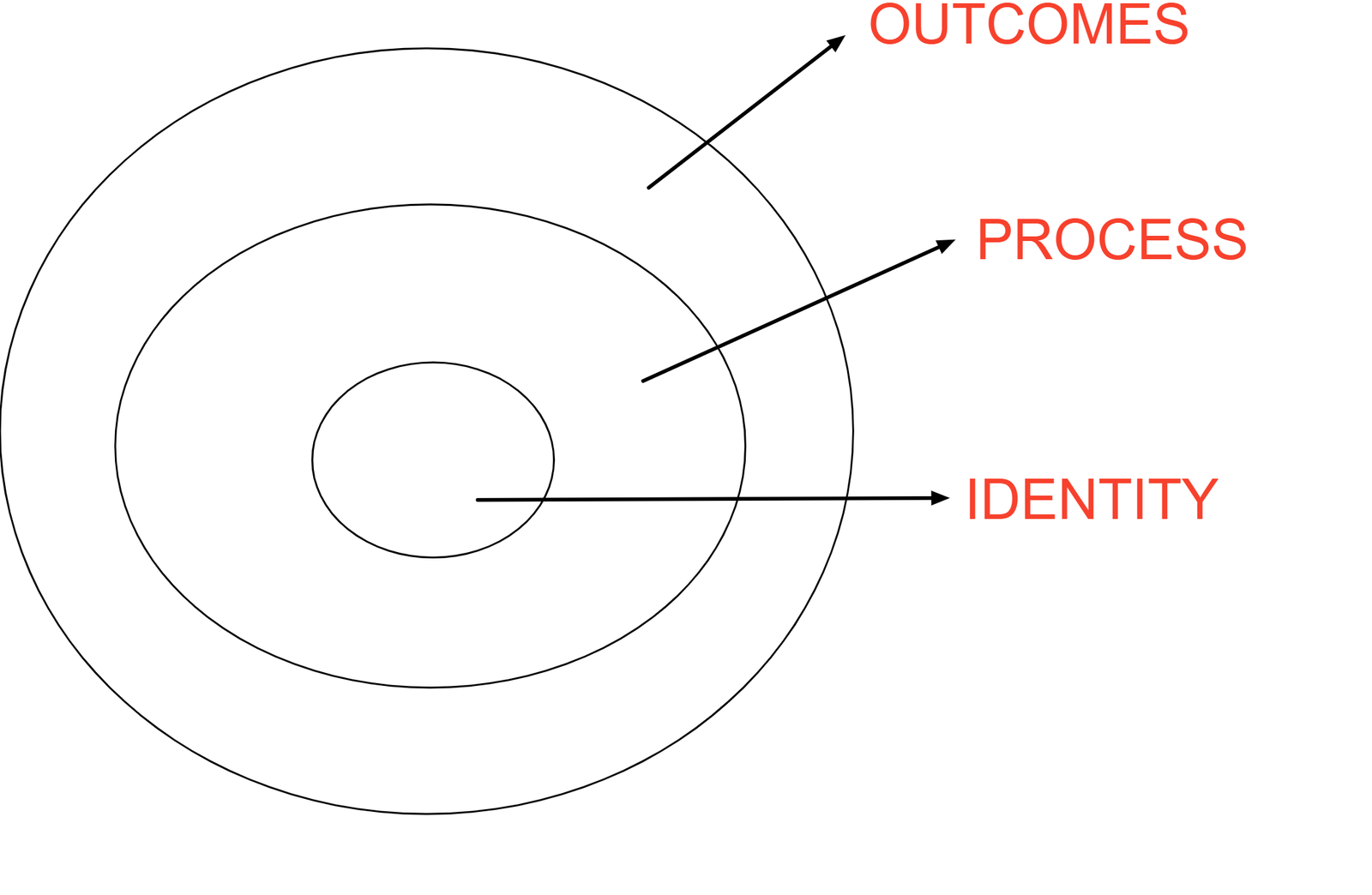
Reference: Atomic Habits by James Clear
So, either you change the outcome directly by changing your goals.
Or you build habits or change the system that you follow.
Or you shape your identity.
In the long term, identity change works the best because you adopt beliefs that harmonize with your desired behavior.
Beliefs don’t change quickly, right? That’s why they stick for a very long time.
And if you talk about goals. They can be changed instantly.
You must have realized why we talked about building systems – instead of setting unrealistic goals.
Now:
If you look closely, you’ll find that if you change the deeper level, which is “identity,” your surface-level behavior will change too.
Your identity and behavior are related.
Your goals and your systems will also change due to the change in identity.
Here is the caveat:
If you build bad habits, you make a terrible identity.
Remember? They both affect each other.
You must deliberately decide precisely the type of person you wish to be.
Habits are so fundamental that they are often undetectable.
Most people never pay attention to their bad habits until they realize that it’s too late. It then becomes hard to get rid of them.
For example:
You may develop a habit of watching Netflix. It’s fun, right?
Such habits often slip into our daily routines and become part of our identity.
You should ask yourself:
What type of person do I want to be?
What would my ideal version of myself look like?
What habits would my perfect self adopt?
Most people never ask these questions to themselves. Result? They adopt bad habits and waste a lot of time.
If you are clear about who you want to be, you’ll find habit-building easy.
And with a little more effort, you’ll be able to master it for good.
Make your desired behavior the obvious thing to do
As I told you, habits shouldn’t be too hard in the initial days. Otherwise, you’ll struggle to stick to them.
The easiest way to do that is to make your desired behavior the most obvious.
How? Allow me to explain.
Let’s say you want to build a habit of going on a morning run every day.
Now think:
How can you make it more prominent?
You can try putting your shoes near your bed so that you see them first – right after you get up from your bed.
Make them more visible.
It sounds simple and stupid. But it works!
These simple things allow you to build a habit that lasts.
Imagine if your shoes are not visible to you after you wake up. What would happen?
You may get distracted. Or find it difficult to get ready and go for running.
You may even find a sweet excuse.
I don’t mean that you’ll do all those things.
The point is:
Make your desired behavior anticipatory.
Try to play with your environment a little.
You can even trick yourself by setting up cues in your environment to trigger your desired behavior.
Make your desired behavior highly irresistible
Think of the time when a highly anticipated movie or TV serial gets released or aired.
Doesn’t it become tempting?
So what do most people do then? Yes, they watch that movie.
The point here is:
We tend to do things that are pleasurable and highly irresistible.
Now let’s understand what exactly is happening here.
The movie is released → Hype is created → We seek pleasure → We watch the movie → Dopamine is released
Isn’t it similar to our little habit loop?
Cue → Craving → Behavior → Reward
In short:
If something creates a craving inside us, we start seeking reward (which is pleasurable).
Generally speaking, we want to get pleasure and avoid pain.
How can you use this critical insight to master habits?
First, figure out what habits you want to adopt.
Then attach a reward to it:
If you complete [task], you’ll get [reward].
This way, your desired behavior will be easy to adopt. And all you have to do is to repeat the same process over and over again.
Soon, you’ll find that you’ve developed your desired habit.
Want an example? Okay.
Let’s say I want to build a reading habit.
Reading can be tedious at times, right?
Here, my desired habit is:
To read one chapter a day from any book.
So what I will do is I’ll set a reward for myself:
If I [finish reading a chapter], I’ll reward myself with [$25].
This way, I’ll be able to build a reading habit for myself.
It won’t be that easy, but you’ll see some progress over time.
Got the point? Alright.
You can apply the same process to get rid of undesired behavior too.
For example, if you want to get rid of your habit of playing games for too long, you can put a penalty for playing extra hours.
You can associate some form of pain by sticking to the bad habit you wish to get rid of.
And then repeat the same process over and over again.
Your family and friends influence your habits
You may have already realized this.
Your family and friends are the ones you spend most of your time with.
As a result, chances are your habits will be similar to the people in your inner circle.
The question is:
How can you utilize this information for developing your desired habits?
Join a group of people who have your desired trait.
Let’s say you want to build healthy eating habits. In that case, you can join a group of health and fitness-conscious people.
This works because it’s our human nature to seek recognition and respect from others.
We want other people to think highly of us. So we avoid doing those things that may hurt our reputation or lower our status.
Put in simple words: we try to fit in.
Maybe you don’t care what others think of you. That’s okay!
But for most people, it can be a big deal.
They try hard to get acceptance from people they like. So eventually, they adopt habits that are considered respectable.
Make sure you don’t join the company of people who have undesirable traits. It’ll hurt you in the end.
For instance, if you hate the habit of eating junk food, stay away from those who have unhealthy habits.
The author says that you should find yourself an accountability partner. It’d help you to stay on track.
Most people usually give up when things get boring. If you have an accountability partner, they will help you remind your goal or the reason you started building a habit in the first place.
The reason why good habits are hard
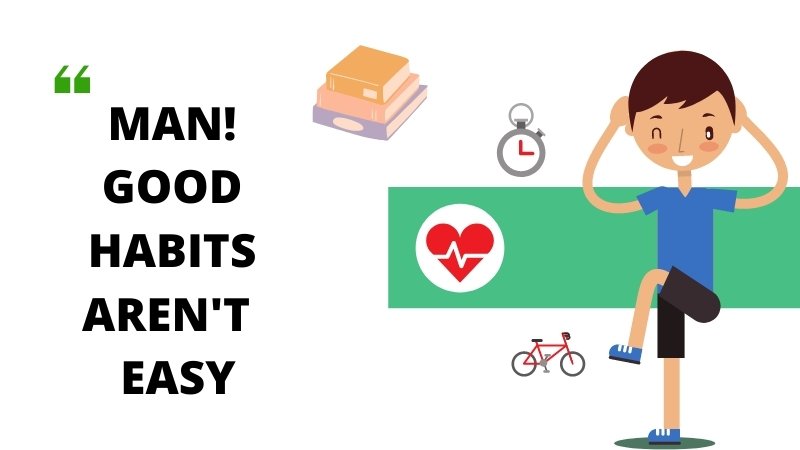
The author says that habits are like a double-edged sword. So you need to be careful and aware of what habits you adopt.
The problem is:
Most good habits don’t give you an instant reward. On the flip side, bad habits are tempting and provide you with instant gratification.
- Waking up at 5 am and doing exercise can be boring. You don’t get to see a fit body the next day. It usually takes days or months to build a good physique.
- But eating chips and chocolates or any junk food is easy and pleasurable. You can instantly reward your tongue and feel good after eating them.
If you are offered to choose between both of them, which one would you choose? I bet most people would prefer to do the second thing.
(No judging here!)
The reason is simple:
We want to avoid pain and get pleasure.
(I’ve started to sound like a broken record)
So what now?
The takeaway here is:
Good habits often demand delayed gratification.
Precisely the opposite of what bad habits require!
The author says that most good habits come at a price: To become a high performer, you must be able to fall in love with boredom.
Most people don’t like boredom.
Boredom is BORING!
The author says that this ability to show up despite being bored separates professionals from amateurs.
For instance, professional writers show up and write – no matter how they feel.
But on the other side, amateur writers only write when they are motivated.
Is writing a good habit or bad? Of course, it’s a great habit.
Just as it is with every good habit, writing can be boring too. But the rewards are often delayed.
So most people just give up! Simple.
Being in action is different than being in motion
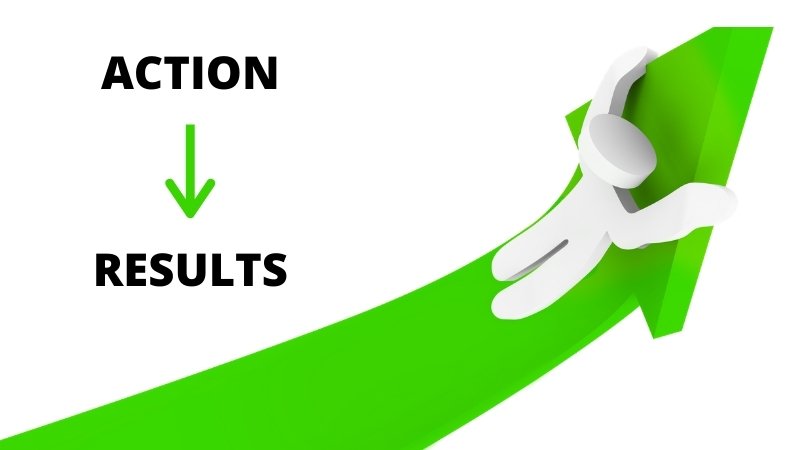
All of us want to improve, right?
Otherwise, why would you be reading about habits?
But do you know that you’re not in motion while you are reading anything?
Yes, you are not taking any action right now.
Wait! Let me put this into perspective for you.
“While you are planning or strategizing, you’re not producing any outcomes.”
Does this mean that planning isn’t necessary? No.
Many people often get stuck in the learning loop. They get an illusion that they are getting closer to their results while they are learning.
But in reality, when you learn anything, you don’t produce any result. It only gives you a sense of progress.
It’s as if you are walking towards your goal.
When you take action, you start running towards your goals. Then you produce results.
The takeaway here is:
Don’t get stuck in the planning phase.
Learn as much as you can. Implement what you learn.
It’s nice to read how habits work. But if you don’t apply any lesson from this book, it’s just a waste of time.
It feels nice to have more information. But at the end of the day, it’s the action that gives you results.
Let’s say your goal is to make six-packs abs. You can immerse yourself in the ocean of content that’s available on the Internet.
You can read all the blog posts. You can consume all the courses out there.
But if you don’t exercise – it’s just a waste of time and money.
Here is another example:
Let’s say you want to become a millionaire like Elon Musk.
You can read so much about him. You can spend a ton of money on all the information courses.
But if you don’t get out of your comfort zone and start a small business, you’ll never see the results.
Once again, allow me to hammer it on you:
You only get results when you take action!
Be deliberate with your habits to achieve mastery
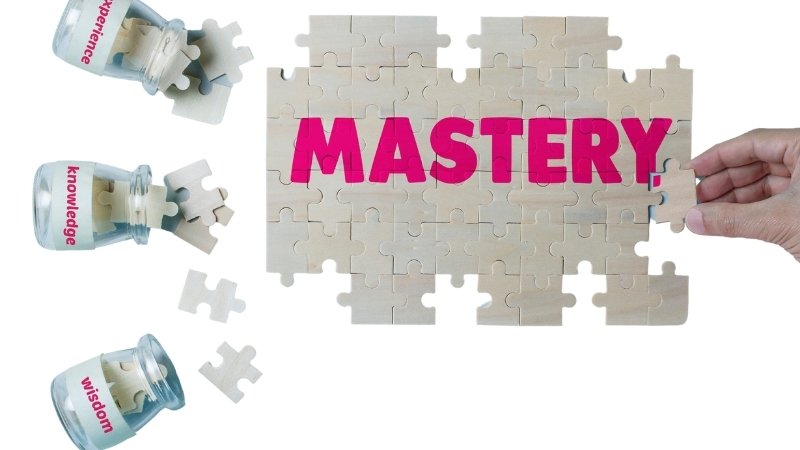
If you think that habits alone would help you succeed, you’re wrong.
The author has made this pretty clear in this book.
He says that you also need deliberate practice to achieve mastery.
You need to be strategic.
You’ll need the determination to stick to those habits.
Habits don’t last if you are not determined and strategic enough.
Sometimes, you’ll require a bit of motivation too.
I’m talking about building good habits here.
Bad habits are easy. You don’t need to be determined to build any bad habits.
Mastery is what requires deliberate effort.
To achieve mastery, you’ll need to fall in love with the process.
I’m talking about the process of improving yourself by making conscious and deliberate efforts.
My personal opinion is if you are not intentional about building the right habits, bad habits will come to you.
Our brain always finds some way to create habits to save energy.
“The most effective form of learning is practice – not planning.”
James Clear
The serious problem with habits that you must know about
Habits are awesome.
But they have got a downside too.
When you get used to certain behaviors, you stop consciously thinking about them.
It lets you slip into procrastination.
How many times do you think about brushing while brushing your teeth? You just do it, right?
But did you know that just because we don’t consciously brush our teeth, it can cause many dental problems?
Many people develop bad brushing habits.
And as a result, they develop dental problems.
It’s just an example of how habits can create problems in the future.
How to fix this problem?
You can monitor your patterns.
These days, there are so many tools available.
The author (James Clear) recommends using a Habit Tracker tool.
It can be exciting, you know?
You can also give yourself challenges, just like any game.
It may help you kill boredom while building habits.
The key takeaways from the Atomic Habits Summary
Let’s recap what we just learned from this book:
- To achieve remarkable results, build systems instead of goals.
- Make your desired habits easy, attractive, obvious, and satisfying.
- Habits require deliberate practice to achieve mastery.
- Not all habits are right for you. Learn to avoid bad ones by making them harder.
- Real results come from real action. Learning is a part of it – it doesn’t produce the outcome.
- Good habits take time. While the bad habits come easily to you.
My Favorite Quotes from the Atomic Habits by James Clear
Here are some of my favorite quotes from this book:
“Habits are the compound interest of self-improvement.”
James Clear
“Habits are a double-edged sword. They can work for you or against you.”
James Clear
“Sometimes, success is more about making good habits easy and bad habits hard.”
James Clear
Atomic Habits Book Review
I’m glad that I read this book.
This book is undoubtedly the #1 New York Times Best Seller.
What makes this book great is how super-practical it is.
You can just open a chapter of this book and immediately start applying the lessons in your life.
This book deserves to be on your bookshelf.
I’d highly recommend this book to everyone who wants to have remarkable results in anything in his life.
No matter your profession, you can find something in this book that will help you become successful.
The only problem in this book is that most ideas are simple and old. You might already know a few things if you read many books like me.
Some pieces of advice don’t work.
For example, there are thousands of habit tracking tools.
It sounds good in theory.
But in reality:
Most apps are just useless.
In reality, you’ll need the determination to add a habit to your routine deliberately. The author has talked about this in the book, though.
I believe that if you apply what the author says, you’ll achieve remarkable results.
The reason?
Because all the information that the author has shared is based on principles and human behavior, which hardly change.
So go check this book out and get a deeper understanding of habits.
This book is an absolute must-read. (Especially for people who are new to the self-help world)
Book Rating: 9/10
Further Reading
There are many more books like Atomic Habits.
If you want to learn more about habits, I’ve curated a list of books like atomic habits that you should read.
List of books like Atomic Habits.
Now it’s your turn!
I hope you got a lot of value from this summary.
Now you tell me:
What high-performance habits do you want to build?
Are you struggling to develop any habits?
Let me know in the comments below.
And as always, if you liked this summary, share this summary as much as you can with your friends. It’d help me in my mission to help people learn great stuff.
Want to consume more insightful, power-packed content like this in the future?
Subscribe to the weekly email newsletter.
Subscribe to YouTube channel for animated video books.
Try Amazon’s Audible 30-days Free Trial and Get 2 Audiobooks for free.


Thanks for advices sir
Glad to help 🙂